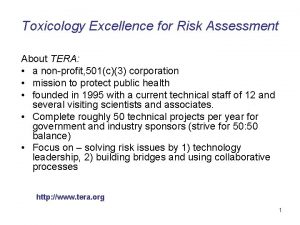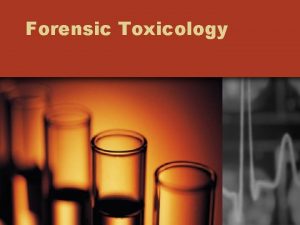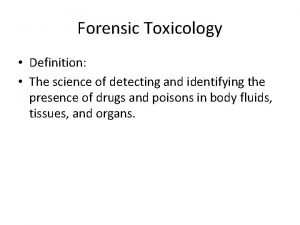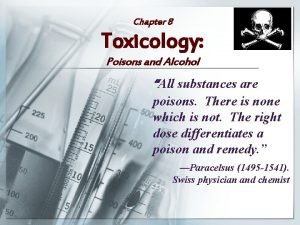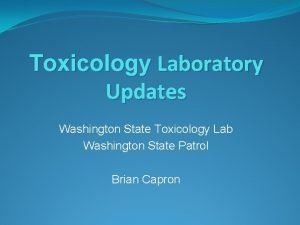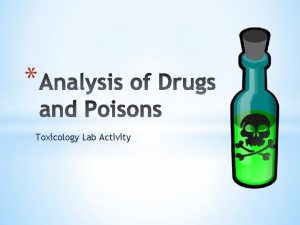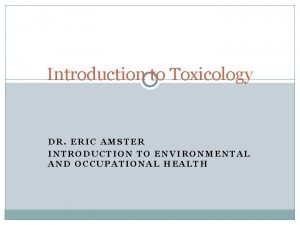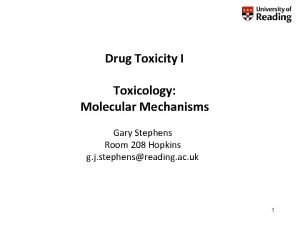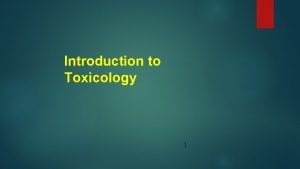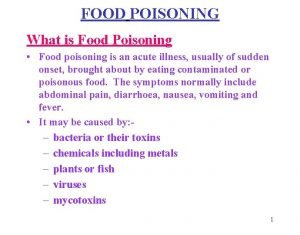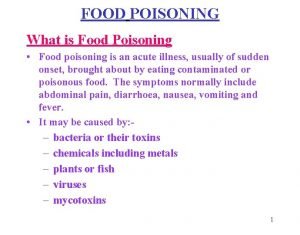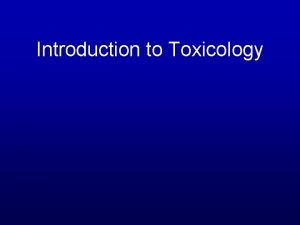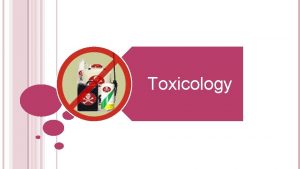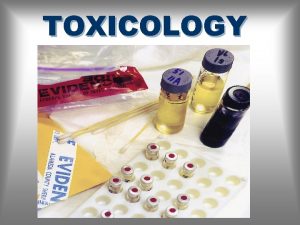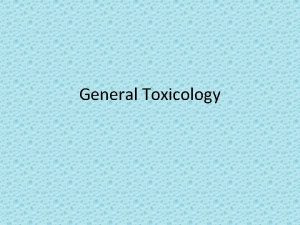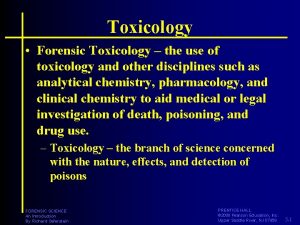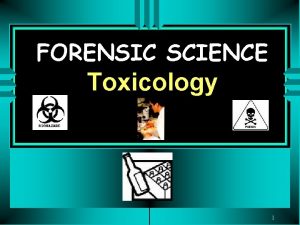TOXICOLOGY MANAGEMENT INTRODUCTION POISONING MANAGEMENT Optimal management of

















- Slides: 17

TOXICOLOGY MANAGEMENT INTRODUCTION

POISONING MANAGEMENT Optimal management of the poisoned patient depends upon The specific poison(s) involved. The presenting and predicted severity of illness. Elapsed time between exposure and presentation.

Treatment variably includes Emergency Management Supportive care Decontamination Antidotal therapy Enhanced elimination techniques.

Management of the poisoned patient begins with evaluation, recognition that poisoning has occurred identification of the agent involved, assessment of severity, and prediction of toxicity Provision of supportive care Prevention When of poison absorption appropriate, the administration of antidotes. Enhancement of elimination of the poison.

1. EMERGENCY MANAGEMENT On first contact with the patient, assessment of the level of consciousness is important. For an unconscious patient, careful evaluation of the Airway, Breathing and Circulation (ABC)

A – Airway. A patent airway is critical in the further management of the patient. Patency may be maintained by one or more of the following, if the patient is unconscious: a) THE HEAD-TILT, chin-lift technique or the classical jaw thrust would be the initial method of choice. However, in the event that neck trauma is suspected, the head tilt should not be employed. The modified jaw thrust is an alternative technique that may be employed in traumatized patients.


b) INSERTION OF ORO-PHARYNGEAL OR NASOPHARYNGEAL AIRWAY with regular suctioning. Prior to this the oral cavity should be inspected any obvious foreign bodies such as food or broken dentures should be removed.

c) TURNING THE PATIENT TO THE RECOVERY (threequarters prone) position. This allows oral secretions and vomitus in the oro-pharynx to drain out of the mouth.

d) ENDOTRACHEAL OR NASOTRACHEAL INTUBATION. If performed, this should only be with a cuffed tube.

B – Breathing. Assessment of breathing should include not just whether the patient is breathing, but also if the breathing is slow or fast. Any patient with abnormal breathing should be provided with 100% oxygen. Slowing of respiration may be a sign of narcotic overdose and assisted ventilation, either via a bag-valve mask or positive pressure Ventilation may be instituted.

C – Circulation. Assessment of circulation should include heart rate, blood pressure, peripheral circulation and hydration status of the patient. To maintain the circulation: - Ideally, the systolic blood pressure (BP) should be kept above 90 mm. Hg Dopamine and dobutamine may be needed to maintain the BP. IV fluids (crystalloids, colloids) may be necessary CVP monitoring may be necessary The patient may require ECG monitoring If in shock, the patient should be maintained in the head down position.

Other Problems. The patient may also have other problems e. g. altered mental states, seizures, etc. These will have to be dealt with urgently; in addition, empirical antidote administration may prove to be necessary. In some cases of impaired consciousness, measuring the blood glucose level may be useful.

Supportive care Airway protection by endotracheal intubation should be performed early in the poisoned patient with depressed mental status because of the high risk for aspiration and its associated complications, particularly when gastric decontamination procedures need to be undertaken.

Hypotension should be managed initially with intravenous fluids. Vasopressors are required when hypotension does not resolve with volume expansion. Direct-acting vasopressors, such as norepinephrine, have been shown to be more effective than indirect-acting agents, such as dopamine, when tricyclic antidepressants have been ingested.

Hypertension in agitated patients is best treated initially with nonspecific sedatives such as a benzodiazepine. When hypertension necessitates specific therapy because of associated end-organ dysfunction, preferred treatments are verapamil or other calcium-channel blockers, phentolamine, labetalol, or nitroprusside.

Ventricular tachycardias are generally treated with standard doses of lidocaine. However, when they occur in the context of intoxication with tricyclic antidepressants or other membrane-active agents, sodium bicarbonate is indicated as first-line therapy.
 Toxicology management
Toxicology management What is toxicology?
What is toxicology? Toxicology excellence for risk assessment
Toxicology excellence for risk assessment Forensic science history timeline
Forensic science history timeline Toxicology definition
Toxicology definition A breath test reflects the alcohol concentration in the:
A breath test reflects the alcohol concentration in the: Forensic toxicology definition
Forensic toxicology definition Definition of environmental toxicology
Definition of environmental toxicology Chapter 8 toxicology poisons and alcohol
Chapter 8 toxicology poisons and alcohol Chapter 8 toxicology test
Chapter 8 toxicology test Washington state patrol toxicology lab
Washington state patrol toxicology lab Forensic toxicology lab activity
Forensic toxicology lab activity Toxicology definition
Toxicology definition Toxicology and applied pharmacology
Toxicology and applied pharmacology Nc medical examiner and coroner guidelines
Nc medical examiner and coroner guidelines Toxicology
Toxicology Examples of toxicology
Examples of toxicology Therapeutic index
Therapeutic index


